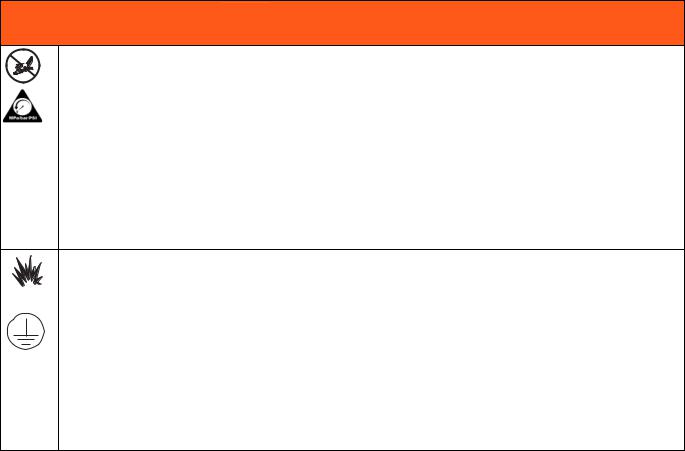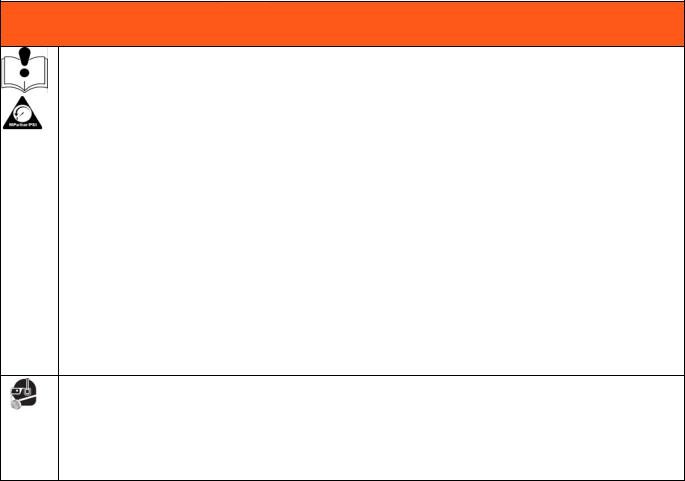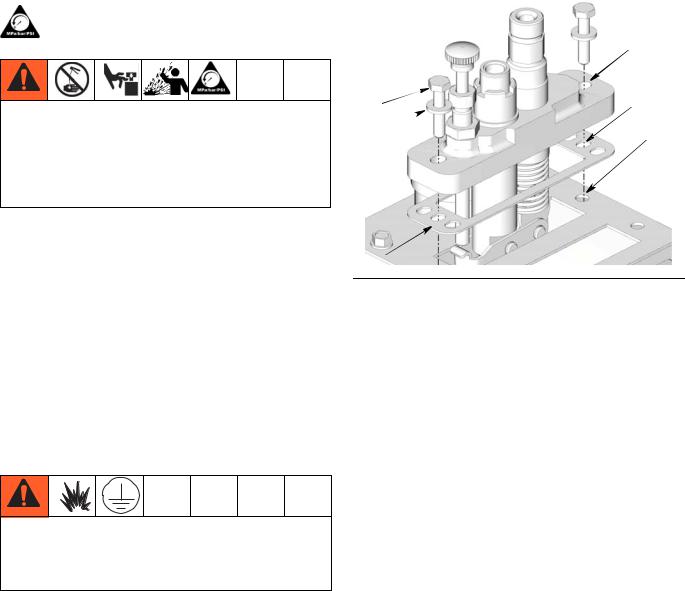Graco 24J398, 24J394, 24J399, 24K466, 24J397 User Manual
...
Instructions
GBL 7500 Box Lubricator
Pump
GBL Shaft Rotation/Low Level
Alarm Pump
3A2257C
EN
GBL 7500 Box Lubricator Pump: Fully enclosed, self-lubricating, precision, metering pump capable of pumping small flows of either mineral or synthetic oil to machinery injection points. For professional use only.
GBL Shaft Rotation/Low Level Alarm Pump: Fully enclosed, self-lubricating, precision, alarm pump capable of sensing shaft rotation and oil low level. For professional use only.
3/16” models: 7500 psi (51.7 MPa, 517 bar) Maximum Working Pressure 1/4” models: 6000 psi (41.4 MPa, 414 bar) Maximum Working Pressure 3/8” models: 3500 psi (24.1 MPa, 241 bar) Maximum Working Pressure Alarm Pump: 200 psi (1.4 MPa, 14 bar) Maximum Working Pressure
Important Safety Instructions

 Read all warnings and instructions in this manual. Save these instructions.
Read all warnings and instructions in this manual. Save these instructions.
Models:
Suction Models
•24J391 - 3/16”
•24J392 - 1/4”
•24J393 - 3/8”
Gravity Models
•24J394 - 3/16”
•24J395 - 1/4”
•24J396 - 3/8”
Pressure Models
•24J397 - 3/16”
•24J398 - 1/4”
•24J399 - 3/8”
Suction Model Shown
Alarm Pump Model
•24K466

Warnings
Warnings
The following warnings are for the setup, use, grounding, maintenance, and repair of this equipment. The exclamation point symbol alerts you to a general warning and the hazard symbols refer to procedure-specific risks. When these symbols appear in the body of this manual, refer back to these Warnings. Product-specific hazard symbols and warnings not covered in this section may appear throughout the body of this manual where applicable.


 WARNING
WARNING
SKIN INJECTION HAZARD
High-pressure fluid from dispensing device, hose leaks, or ruptured components will pierce skin. This may
+
look like just a cut, but it is a serious injury that can result in amputation. Get immediate surgical treatment.
•Do not point dispensing device at anyone or at any part of the body.
•Do not put your hand over the fluid outlet.
•Do not stop or deflect leaks with your hand, body, glove, or rag.
•Follow the Pressure Relief Procedure when you stop dispensing and before cleaning, checking, or servicing equipment.
•Tighten all fluid connections before operating the equipment.
•Check hoses and couplings daily. Replace worn or damaged parts immediately.
FIRE AND EXPLOSION HAZARD
When flammable fluids are present in the work area, such as gasoline and windshield wiper fluid, be aware that flammable fumes can ignite or explode. To help prevent fire and explosion:
•Use equipment only in well ventilated area.
• Eliminate all ignition sources, such as cigarettes and portable electric lamps.
• Keep work area free of debris, including rags and spilled or open containers of solvent and gasoline.
•Do not plug or unplug power cords or turn lights on or off when flammable fumes are present.
•Ground all equipment in the work area.
•Use only grounded hoses.
•Stop operation immediately if static sparking occurs or you feel a shock. Do not use equipment until you identify and correct the problem.
•Keep a working fire extinguisher in the work area.
2 |
3A2257C |

Warnings


 WARNING
WARNING
EQUIPMENT MISUSE HAZARD
Misuse can cause death or serious injury.
•Do not operate the unit when fatigued or under the influence of drugs or alcohol.
•Do not exceed the maximum working pressure or temperature rating of the lowest rated system component. See Technical Data in all equipment manuals.
•Use fluids and solvents that are compatible with equipment wetted parts. See Technical Data in all equipment manuals. Read fluid and solvent manufacturer’s warnings. For complete information about your material, request MSDS from distributor or retailer.
•Do not leave the work area while equipment is energized or under pressure.
•Turn off all equipment and follow the Pressure Relief Procedure when equipment is not in use.
•Check equipment daily. Repair or replace worn or damaged parts immediately with genuine manufacturer’s replacement parts only.
•Do not alter or modify equipment. Alterations or modifications may void agency approvals and create safety hazards.
•Make sure all equipment is rated and approved for the environment in which you are using it.
•Use equipment only for its intended purpose. Call your distributor for information.
•Route hoses and cables away from traffic areas, sharp edges, moving parts, and hot surfaces.
•Do not kink or over bend hoses or use hoses to pull equipment.
•Keep children and animals away from work area.
•Comply with all applicable safety regulations.
PERSONAL PROTECTIVE EQUIPMENT
Wear appropriate protective equipment when in the work area to help prevent serious injury, including eye injury, hearing loss, inhalation of toxic fumes, and burns. This protective equipment includes but is not limited to:
•Protective eye wear, and hearing protection.
•Respirators, protective clothing, and gloves as recommended by the fluid and solvent manufacturer
3A2257C |
3 |

Warnings
Pressure Relief Procedure
Follow the Pressure Relief Procedure whenever you see this symbol.
I
This equipment stays pressurized until pressure is manually relieved. To help prevent serious injury from pressurized fluid, such as skin injection, splashing fluid and moving parts, follow the Pressure Relief Procedure when you stop pumping and before cleaning, checking or servicing the equipment.
1.Stop lube pump.
2.If installed, close oil supply valve located upstream from pump.
3.If installed, open drain valve located downstream from the pump.
4.Slowly crack open fluid line fittings to relieve pressure.
Installing the Pump
Grounding
The equipment must be grounded to reduce the risk of static sparking. Static sparking can cause fumes to ignite or explode. Grounding provides an escape wire for the electric current.
Ensure the reservoir is properly grounded as the pump is grounded through the mounting screws.
Mounting Pump
NOTE:
•Ensure box and lube system are sized appropriately for the selected pressure.
•Ensure an appropriate pressure relief device, suitable for your application, is installed in the system.
•Inspect your box lubricator and replace any damnaged or worn components.
|
d |
e |
b |
f |
c |
a
FIG. 1
1.Ensure the pump mounting surface on the reservoir cover is clean. Clean as needed.
2.Align gasket (a) with opening on the top of the reservoir cover making sure holes (b) on either end of the gasket match mounting holes (c) in reservoir cover (FIG. 1).
NOTE: Alarm Pumps Only - For optimum performance, mount alarm pump in location furthest from drive motor.
•For Gravity and Pressure Fed pumps, skip Step 3 and continue installation with Step 4.
•For Alarm pumps skip Step 3a and continue installation with Step 3b.
•Pressure Fed pumps follow Step 3a and 3b.
3.For Suction Fed Pumps install pump inlet strainer:
a.Check length of suction tube. If it is too long to fit in the reservoir, use a pliers to break off the lower section of the tube (a) (FIG. 2).
4 |
3A2257C |

a
FIG. 2
b.For all installations (whether the tube needs to be trimmed or can be used without trimming), press strainer onto end of the suction tube until it “bottoms” (FIG. 3).
FIG. 3
4.Orient pump so the roller bearing on the bottom of the pump is aligned with the cam inside the reservoir.
5.Install pump on the reservoir by aligning the holes
(d) on either end of the pump with the mounting holes (c) in the reservoir cover (FIG. 1).
6.Install washers (f) and bolts (e) and wrench tighten them securely. Torque bolts as recommended in your reservoir instruction manual.
Setup
Setup
NOTICE
Any pressure applied to the pump inlet has the potential to cause unrestricted flow from the pump outlet even in a pump that is at rest or adjusted for zero stroke. To prevent this from happening, install a check valve of a comparable pressure rating at the pump outlet.
NOTE: The internal “discharge check valve” does not have a spring and is rated at zero psi.
I
1.Expel all air from pump and relieve pressure (page 4).
NOTE:
•Do not connect the oil line to the pump outlet or lube point until all air has been expelled.
•Use filtered oil when priming the pump.
•Filter oil with minimum 25 micron strainer. Machine requirements may require a higher cleanliness level.
•Maximum allowable inlet pressure:
-Pressure Fed Pump: 100 psi (0.69 MPa, 6.9 bar)
-Gravity Fed Pump With Sight Glass: 10 psi (0.07 MPa, 0.7 bar)
•Minimum required inlet pressure for priming:
-Pressure Fed Pump: 1 psi (0.007 MPa, 0.07 bar)
-Gravity Fed Pump: N/A
-Suction Fed Pump: N/A
-Alarm Pump: N/A
2.Prime the pump using the procedure described in the following section that relates to your pump model.
3A2257C |
5 |

Setup
Suction Fed Models (FIG. 4)
5 |
|
|
|
|
1 |
|
|
|
|
||
|
|
|
|
|
3
6
2
4 
FIG. 4
1.Remove the sight well plug (1) and outlet plug (5). Discard outlet plug (5).
2.Fill the sight well (2) to the top with appropriately filtered oil.
3.Operate the hand priming assembly (3) until the oil level drops below the end of the drip tube (4).
4.Apply thread sealant (user supplied) to sight well plug (1).
5.Replace the sight well plug (1), taking care to not allow any thread sealant into the sight well (2).
6.Torque sight well plug (1) to 35 + 5 in. lbs (3.95 + 0.6 N.m).
7.Continue to hand prime until oil expelled from the outlet (6) is free of air.
8.If all oil is evacuated from sight well (2), repeat steps 2 - 7 as often as necessary, until all air has been expelled.
Gravity Fed Models (FIG. 5)
NOTE: In the following instructions, the fill line refers to the inlet line.
 1
1
5
3
6
2 
FIG. 5
1.Remove and discard the sight well plug (1) and outlet plug (5).
2.Fill the sight well (2) to the top with appropriately filtered oil.
3.Operate the hand priming assembly (3) until the oil level drops below the end of the drip tube (4) (FIG. 4).
4.Apply thread sealant (user supplied) to fill line fitting.
5.Connect fill line to sight well (2), taking care to not allow any thread sealant into the sight well.
6.Torque fill line fitting to 35 + 5 in. lbs (3.95 + 0.6 N.m).
7.If installed, open oil supply valve located upstream from the pump.
8.Continue to hand prime until oil expelled from outlet
(6)is free of air.
9.If all oil is evacuated from sight well, repeat steps 2 - 8 as often as necessary, until all air has been expelled.
6 |
3A2257C |
